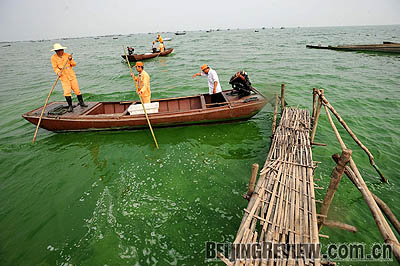|

As spring warms into sultry summer, blue-green algae has been spotted again in Chaohu Lake, China's fifth largest freshwater lake measuring about 760 square km in the eastern province of Anhui.
Due to a long spell of warm, dry weather, patches of algae were found in the western part of the lake, and traces of algae also cropped up in the eastern part, said Xiao Pu, an official of the Anhui Provincial Environment Protection Bureau, in a Xinhua News Agency report.
The lake supplies drinking water to about 260,000 regular residents in the urban areas of Chaohu on its eastern bank.
"Normally, algae needs a proper proportion of nitrogen and phosphorus, continuous temperatures above 25 degrees centigrade and strong sunlight for at least three days to thrive," Xiao said. "Although there are no signs of a massive bloom of algae in the lake, current conditions are conducive to algae growth."
Blue-green algae is a simple aquatic plant that sprawls naturally in rivers, lakes, damp soil, tree trunks and hot springs.
"Bloom" is the term used to describe an increase in the number of alga cells to a point where they can discolor the water, form scum, produce unpleasant tastes and odors, affect shellfish and fish populations or otherwise create a nuisance and seriously reduce the water quality.
Chaohu Lake has been heavily polluted in four consecutive months since this February.
Xiao attributed the situation to the heavy snowfalls early this year. "When the snow melted, the water carried fertilizers and other nutrient runoffs to the lake, bringing the content of nitrogen and phosphorus to a higher level."
The provincial environmental authority has ordered local environmental officials to enhance monitoring of the lake, improve pollution supervision over local enterprises and pan for alternative water supplies.
"We will coordinate with the local water resource bureau to divert water from the Yangtze River to Chaohu Lake for pollution dilution, and ensure the safety of drinking water in case of an algae outbreak in the lake," said Zhang Zhiyuan, spokesman of the Anhui Province Environment Protection Bureau.
The Chaohu fishery administration has dumped a total of 1.6 million silver carp fry into the lake in February, in hopes that they will gobble up the algae pollutions and make this summer different from previous ones.
They expected each fish to eat as much as 100 pounds of algae as they grow and help to revive a local fishing industry.
But the lake has been dangerously polluted for more than a decade. Algae returned as usual this June, thanks to a steady diet of nitrogen, phosphorous and other nutrients provided by two industrial cities, Chaohu and Hefei on the north bank of the lake.
Across the country, officials are desperate to meet a national goal of restoring China's severely polluted lakes by 2030.
From June to August last year, nutrient runoffs and other pollutants caused blue-green algae blooms in Taihu, Chaohu and Dianchi lakes, endangering water supplies for nearby cities and threatening aquatic life.
The worst algae outbreak was in the eastern Taihu Lake, the country's third largest freshwater lake, and it made tap water undrinkable for about 10 days for more than 1 million people in Wuxi, Jiangsu Province.
As a solution, the Wuxi Environment Protection Bureau shut down more than 770 chemical plants around the lake in a bid to curb the pollution last year. | 